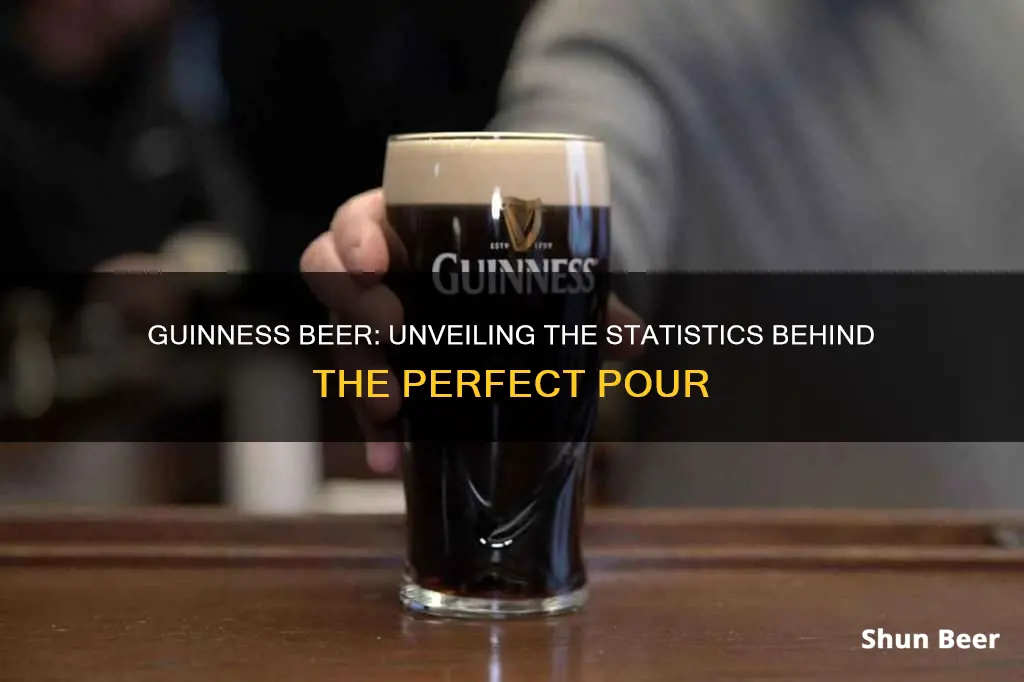
The world's most common test of statistical significance, the t-test, was invented by William Sealy Gosset, a head brewer at Guinness. Gosset's work allowed scientists to make accurate predictions based on small amounts of data. Gosset's work was particularly useful for brewers, who could save money by taking fewer samples of their product. Gosset's work was so important that it is now included in statistics textbooks and used in all fields that utilise statistics, from medicine to agriculture.
What You'll Learn
- The t-test: a statistical technique invented by Guinness brewer William Sealy Gosset
- The t-distribution: Gosset's method for making accurate predictions based on small amounts of data
- Student's test of statistical significance: Gosset's pseudonym was Student
- The Guinness brand: worth approximately $4 billion, making it one of the most valuable beer brands
- Guinness's history: the beer has been brewed for over 250 years and is available in over 120 countries

The t-test: a statistical technique invented by Guinness brewer William Sealy Gosset
The t-test is a widely used statistical technique with applications across all of science. It was invented by William Sealy Gosset, head experimental brewer at Guinness in the early 20th century.
Gosset was born in 1876 in Canterbury, England, and graduated from Oxford with a degree in chemistry in 1899. He then took a job at the Guinness Brewery in Dublin, Ireland, where he remained until his death in 1937.
At the time, Guinness was the world's largest brewery. The company hired graduates from top universities to bring scientific methods to beer production. Gosset's first publication came in 1907, and he went on to develop new statistical methods that are now central to the design of experiments and the analysis of economic significance.
One of the main problems that Gosset and his team faced was interpreting data from small sample sizes. For example, to assess the quality of hops, brewers needed to measure the plants' soft resin content. Testing every flower in the crop wasn't economically viable, so they took random samples. However, this introduced uncertainty: if the samples had a low resin content, was this indicative of the entire crop, or had they just been unlucky in their selection?
Gosset recognised that the standard approach to determining statistical significance only worked with large sample sizes. Small samples of hops wouldn't guarantee a normal distribution. So, he meticulously tabulated new distributions for smaller sample sizes, now known as t-distributions. These plots resemble the normal distribution in that they are bell-shaped, but the curves of the bell aren't as sharp. This meant that an even larger signal-to-noise ratio was needed to conclude significance.
Gosset's t-test allowed scientists to make inferences in settings where it wasn't previously possible. He published his findings under the pseudonym "Student" as Guinness didn't want to tip off competitors to their research. Although his name has been largely forgotten, his achievement lives on as one of the most widely used statistical tools in science.
Guinness Beer: Decoding Production Dates for Connoisseurs
You may want to see also

The t-distribution: Gosset's method for making accurate predictions based on small amounts of data
The t-distribution is a type of normal distribution used for smaller sample sizes, where the variance in the data is unknown. It was discovered by William Sealy Gosset, a chemist and statistician who worked at Guinness.
Gosset was interested in finding a way to analyse quality data obtained from small sample sizes in his routine work on quality control of raw materials. At the time, it was generally accepted that a large sample size was needed to make statistical inferences. However, Gosset realised that it was neither practical nor economical to analyse hundreds of data points.
In 1906, Gosset was sent to Karl Pearson's laboratory at University College London, where he discovered the "Student's t-distribution". This was a groundbreaking development in statistics, as it provided a way to use small sample-sized data to make predictions about a wider population.
The t-distribution is symmetric and resembles the normal distribution but with stronger "tails" due to the extra variability in smaller sample sizes. It uses the sample standard deviation to estimate the population standard deviation, which is unknown.
Gosset published his findings in 1908 under the pseudonym "Student", as his employer, Guinness, objected to him revealing their gained advantage in using this procedure to select the best varieties of barley and hops for their beer. This is why the t-distribution is also known as "Student's t-distribution".
Today, the t-distribution is routinely used for checking results for significance bias and comparing measurements of two sets of results and their means. It is also important for calculating confidence intervals.
Prepare Delicious Corned Beef with Guinness Beer at Home
You may want to see also

Student's test of statistical significance: Gosset's pseudonym was Student
In the early 20th century, Guinness was the world's largest brewery, having been in operation for almost 150 years. The company's leadership decided to revamp its approach to quality control, targeting consistency and industrial-grade rigour to meet the demands of global expansion. This led to the hiring of William Sealy Gosset, a statistician, chemist, and brewer who would become the head experimental brewer at Guinness.
Gosset's work focused on developing new statistical methods to improve the quality of Guinness's beer. One of his key challenges was determining the quality of hops, an essential ingredient that imparts a bitter flavour and acts as a natural preservative. To assess the quality, brewers measured the soft resin content of the hops, but testing every flower in the crop was not economically feasible. This led Gosset to develop a method of random sampling.
Gosset's most significant contribution to statistics, however, was the development of the t-test, one of the most important statistical techniques. The t-test is used to determine statistical significance when dealing with small sample sizes. Gosset recognised that traditional statistical methods relied on large sample sizes and the Gaussian normal distribution to describe data. However, in many cases, including his work at Guinness, small sample sizes were more practical and economical.
Gosset's t-test provided a way to make statistical inferences from small sample-sized data. He meticulously tabulated new distributions for smaller sample sizes, now known as t-distributions. These plots resemble the normal distribution but have wider "tails" due to the extra variability in smaller sample sizes.
Gosset published his findings under the pseudonym "Student", as Guinness did not want to reveal their competitive advantage to competitors. Thus, his most famous achievement became known as "Student's t-test" or "Student's t-distribution". The t-test has become one of the most widely used statistical tools in science and has had a profound impact on statistical inference.
Guinness Beer's Ball: A Unique Brewing Mystery
You may want to see also

The Guinness brand: worth approximately $4 billion, making it one of the most valuable beer brands
The Guinness brand is worth approximately $4 billion, making it one of the most valuable and recognisable beer brands in the world. It is also one of the most successful alcohol brands worldwide, brewed in almost 50 countries and available in over 120.
The success of Guinness can be attributed to its unique flavour, creamy texture and innovative marketing campaigns. The brand has a long history of advertising, from television advertisements to beer mats and posters. One of its most notable and recognisable series of advertisements was created in the 1930s and 1940s, featuring animals such as a kangaroo, ostrich, seal, lion and toucan. This series of advertisements helped to establish Guinness as a cult beer in the UK during a time of declining sales.
Guinness has also been at the forefront of quality control and innovation. In the early 20th century, the company hired a team of experts to pursue research questions in service of the perfect brew. This led to the development of new chemical techniques, such as adding nitrogen gas to kegs and cans, which gave rise to the popular nitro brew styles of beer.
Guinness has continued to innovate in recent years, launching alcohol-free beers such as Guinness 0.0% and Guinness Cold Brew Coffee Beer, as well as pioneering new dispense technologies like Guinness MicroDraught. The brand is also committed to sustainability, undertaking a three-year regenerative agriculture pilot in Ireland to reduce the carbon emissions of barley production.
Guinness's iconic status and world-leading position in the stout market have contributed to its lasting value. The brand's success shows how investing in quality, brand building, innovation and long-term strategies can create a valuable and enduring beer brand.
The Cost of Guinness Beer in Ireland
You may want to see also

Guinness's history: the beer has been brewed for over 250 years and is available in over 120 countries
Guinness's History: Over 250 Years of Brewing
The story of Guinness begins with Arthur Guinness, the original master brewer and pioneer. Born in 1725, Arthur was introduced to the art of brewing at a young age through his father, Richard Guinness, who was a land steward for the Archbishop of Cashel. Richard's duties included supervising the brewing of beer for workers on the estate, which likely sparked Arthur's passion for brewing.
On December 31, 1759, Arthur Guinness signed a 9,000-year lease for the St. James's Gate Brewery in Dublin, Ireland, marking the beginning of the Guinness legacy. At the time, the brewery was a small, unused site, and Arthur's entrepreneurial spirit and vision fueled his ambition to create a global brand.
Arthur started by brewing ales and quickly established a successful trade. In the 1770s, he began brewing a new type of English beer called porter, which became so popular that he decided to focus solely on this style. The first known export of Guinness left Dublin for England in 1796, marking a pivotal moment in the brand's global journey.
Over the years, Guinness expanded its reach and diversified its offerings. The West India Porter, first brewed in 1801, evolved into the Foreign Extra Stout, which remains a popular variant in Asia, Africa, and the Caribbean. By the 1880s, St. James's Gate had become the largest brewery in the world, and Guinness continued to innovate and adapt to meet the demands of its growing customer base.
In the early 20th century, Guinness hired a team of experts, including the statistician William Sealy Gosset, to enhance quality control and pursue research in service of the perfect brew. This period saw the development of groundbreaking statistical techniques, such as the t-test, which revolutionized scientific inquiry and remains widely used today.
Guinness has always been committed to innovation and maintaining the highest standards of quality. In the mid-20th century, mathematician-turned-brewer Michael Ash introduced nitrogen to the brewing process, creating the distinctive surge and creamy texture of Guinness Draught. This innovation led to the launch of the world's first nitrogenated beer in 1959, which was immediately embraced by consumers.
Guinness has continued to evolve and expand its global presence. In 1997, it merged with Grand Metropolitan to form the multinational alcoholic beverage company Diageo. Today, Guinness is brewed in almost 50 countries and is available in over 120, with a diverse range of variants and strengths to cater to different markets.
Throughout its history, Guinness has also been known for its philanthropy and commitment to employee welfare. Arthur Guinness himself was a philanthropist, and the company has a long tradition of giving back to the community and supporting its employees, which has contributed to its success and longevity.
Craft Beer Enthusiasts: Guinness Blonde Alternatives
You may want to see also
Frequently asked questions
In 1908, a Guinness scientist and brewer, William Sealy Gosset, published a paper under the pseudonym "Student" that included a method for making accurate predictions based on small amounts of data. This method would later be known as "Student's t-distribution", an integral tool for modern statistics and science.
There is some uncertainty as to why Gosset used a pseudonym. One theory is that Guinness didn't want their competitors to know that they were using scientists to improve their brewing techniques. Another account suggests that it was to prevent the disclosure of confidential information as trade secrets had been revealed in a previous paper published by a Guinness researcher.
The "t-distribution" is featured in statistics textbooks and used in various fields that utilize statistics, such as medicine and agriculture. It helps researchers draw more effective conclusions when working with small sample sizes.
The "t-distribution" can help brewers save money by allowing them to take fewer samples of their product while reducing the risk of accidentally sampling the wrong part of the beer pot, which could result in an inaccurate measurement of alcohol content.







